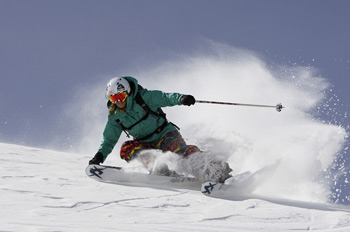Words by: Jon Lipsey

Sea Kayak in Scotland
Swapping your surfboard for a sea kayak gives you more chance of losing the crowd. Sea Kayak Scotland, based on Seil Island 16 miles south of Oban, offer bespoke trips for all abilities. You can either go for a gentle paddle or, if you’re feeling adventurous, take on the eight-knot tidal rapids and 30-foot waves in the gulf of Corryvreckan. Whatever you do, you’ll get “an incredible feeling of remoteness,” promises instructor Ken Lacey. “There will be no-one else where we camp. If we did see another tent, we’d carry on until we found our own campsite.”
Where to kip: Relaxed camping laws in Scotland mean you can pitch a tent anywhere. Alternatively, stay at Seil’s Willowburn hotel, which is run by sea kayakers.
Where to drink: The Oyster Brewery and Restaurant claims to be Scotland’s smallest brewery and has a veranda that overlooks the ocean.
What else is there to do? Get on your mountain bike and head for the trials at Eredine and Raera forests, which have tracks that range from 2-40km long.
Not enjoying the silence? Oban offers the best nightlife in the area. If you’re suffering from real crowd withdrawal, catch the seaplane to Glasgow, which takes 24 minutes and lands in the Clyde River.
How to get there: Sea kayak excursions cost £140 per day for a group (of up to five people). Equipment hire is £10 extra per person. Visit seakayakscotland.com

Cycle through Central America
Costa Rica attracts visitors but neighbours Nicaragua and Panama are almost bereft of tourism, according to Exodus, who offer two week, two-wheeled group tours through the three Central American states. Along the way local guides take you to remote communities and dense rainforest where company comes in the form of parrots and howler monkeys. You cover a hefty 70km a day on the bike but the dramatic scenery – such as the Arenal Volcano, one of the world’s most active lava spewers – should take the edge off your saddle sores.
Where to kip: You stay in a different place each night. The small, family-run stops aren’t luxurious but are big on “character and local style”, says Exodus’s Natasha Owen.
Where to drink: Join local Nicaraguans for a cold beer on the beach at San Juan del Sur, a crescent-shaped bay on the Pacific coast.
What else is there to do? Go surfing at the palm tree lined beaches of Panama’s Bocas del Toro islands.
Not enjoying the silence? Panama City, which you pass through towards the end of the trip, is a bustling mix of gleaming skyscrapers and old-style colonial Spanish buildings.
How to get there: Cycle Nicaragua, Costa Rica and Panama with Exodus travel from £1,899 (including flights and accommodation). Visit exodus.co.uk

Surf in Ghana
If you imagine your ideal surfing destination the scene probably doesn’t include hundreds of people jostling for the same wave and knocking each other out with their boards. That’s because the best surf spots are the ones where it’s you, the waves and not a lot else. And that’s exactly what you get in Ghana, which, according to Errant Surf’s Chris Thompson, is “like Morocco 40 years ago because there are no crowds and the locals are friendly”. You won’t have the four-foot waves and point breaks completely to yourself though; Thompson reckons you’ll have to share the 100-mile stretch of coast with about half a dozen local surfers.
Where to kip: The renovated slave fort at Princes Town is basic (as in no electricity) but you are at least sleeping in a castle.
Where to drink: If you’re after a marathon session, prop yourself up at the Baze bar in Accra, which stays open all weekend.
What else is there to do? Visiting the dungeons where slaves were held before being shipped off to work for European colonisers is a sobering but worthwhile trip.
Not enjoying the silence? Practise your haggling skills and get down to the Wednesday market in Accra, where you can pick up handcrafted statues and munch on local fruit and fish.
How to get there: Ghana Surf Tour with Errant Surf, £1,030 (not including flights). Fly to Accra with KLM from £458 return.
Next: heli-boarding in Russia, snowkiting in Iceland and cross-country skiing in Norway…
Heli-board in Russia
Tucked away in the eastern reaches of Russia, the Kamchatka Peninsula is about as far from the Chamonix crush as you can get while still being on a board. Every morning the helicopter drops you at the top of one of the area’s 160 volcanic peaks. Descents last on average five or six kilometres, which start out steep and often mellow to a finish on the Pacific Ocean. When you get to the bottom, the chopper will be waiting to take you up for a new descent. The area was off limits to both Russians and foreigners during the Cold War and people haven’t exactly flocked to the area since the restriction was lifted in 1990.
Where to kip: As part of the package you get put up in one of Kamchatka’s finest hotels, which, unfortunately, is still pretty basic.
Where to drink: Nightlife is virtually non-existent so at the end of the day you set up camp at one of the hot pools, just like natural Jacuzzis, and sink a few beers.
What else is there to do? The area is home to one of the world’s largest, but sadly dwindling, populations of brown bear, which can be seen roaming around the high peaks.
Not enjoying the silence? Then you’ve come to the wrong place. “If you want to have a social trip it’s not the place to go,” says Mel McIntosh at McNab Snowsports.
How to get there: Eight-day heli-boarding in Russia with McNab Snowsports, 3,450 euros (approx. £2,420). Visit mcnabsnowsports.com

Snowkite in Iceland
With 1,000 square kilometres of powder, the Langjokull Glacier in Iceland offers plenty of solitude. “If you want to get away from the crowds there’s probably no better place,” says Snowkiter’s Robert Brown, who organises week-long tours to the area. “There’s nobody there and no mobile phone reception, which gives you a great sense of freedom.” Each day you strap on your kite and go, quite literally, wherever the wind takes you. You don’t have to be an expert but, if you want to avoid getting dragged off and finding yourself a little too isolated, some experience of snowkiting is a plus.
Where to kip: Bed down in the log cabins included in the trip. They’re close to the glacier and all have hot tubs, a comfort you’ll be glad of after a hard day in the snow.
Where to drink: It’s so remote there aren’t any bars so retire to your cabin with a bottle of Brenavin, a local vodka schnapps which apparently tastes like a cross between Marmite and cough mixture.
What else is there to do? Snowkiter are happy to keep you busy by organising activities like snowmobiling, ice climbing and blue lagoon excursions.
Not enjoying the silence? You spend the first night in the Icelandic capital Reykjavik. Head to Damon Albarn’s old bar, Kaffibarinn, and end the night in a blur.
How to get there: One-week snowkiting package from Snowkiter, £650 (including flights and accommodation). Visit snowkiter.co.uk

Cross-country ski in Norway
It’s not the easiest way to avoid the crowds but your reward for all the huffing and puffing is vast stretches of people-free land. Head to Kvitavatn in Norway and you’ll have 120km of tracks and forest trails virtually to yourself. The summits of Ornenipa and the Heddersfjell moors, both of which rise to about 1,300m, offer some of the best views around for blanket whiteness. And, if you want to give your skis but not your legs a rest, you can try snowshoeing, where you tie what looks like homemade tennis racquets to your feet and plod off into the wilderness.
Where to kip: Mountain lodge-style accommodation is available at Kvitavatn Fjellstoge and is included in the package.
Where to drink: Hotels are generally the only places with licenses so stroll into one and proudly ask for Aass beer, a locally produced pilsner.
What else is there to do? If you fancy a bit of conventional skiing action, there are 20km of downhill slopes in the area, including green, red and black runs.
Not enjoying the silence? The small ski centre down the road at Gaustablikk is about as busy as it gets in this part of the world.
How to get there: Cross-country skiing package from Exodus travel £650. Visit exodus.co.uk
And five to avoid like Bilharzia.
Save viewing the world’s most crowded tourist hotspots for Google earth.
Times Square, New York
With 35 million visitors a year, NYC’s gaudy neon monstrosity is the world’s busiest and, arguably, least tasteful tourist stop.
Machu Picchu, Peru
The ‘lost city of the Incas’ has been found by so many backpackers that it may have to be placed on UNESCO’s World Heritage Site endangered list.
Mount Everest, Nepal
With tourists swelling the population of Kathmandu in the valley below Everest from 40,000 to 700,000 in the summer, it can’t be long before the world’s highest mountain
gets its own Starbucks.
Chamonix, France
The French ski resort attracts around 5 million visitors a year, who all try to get on the same ski lift as you. Or does it just feel like that?
Surfrider beach, Malibu
The Southern California stretch of sand is arguably the world’s most crowded surf spot, attracting around 1.5 million people a year.


